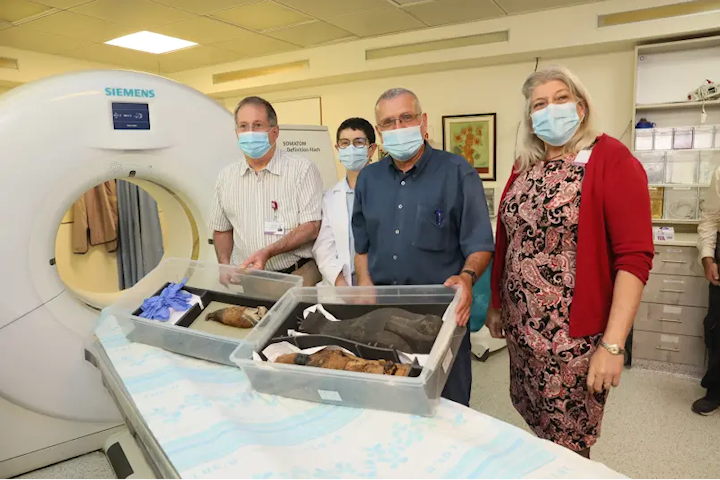An innovative joint project carried out by the National Maritime Museum and Rambam Health Care Campus resulted in two ancient Egyptian mummies being examined using CT scans to determine their content.
 Examining two Egyptian mummies at Rambam Health Care Campus. Photography: Rambam HCC.
Examining two Egyptian mummies at Rambam Health Care Campus. Photography: Rambam HCC.
A palpable sense of excitement recently pervaded the Department of Medical Imaging at Rambam Health Care Campus, when two ancient Egyptian mummies, long part of the treasures of Haifa’s National Maritime Museum, were brought to the hospital for a CT examination. As one of the mummies was scanned, a bird of prey that had been beautifully preserved for more than 2,500 years—most likely a falcon—appeared on the computer screens.
This was a unique project—the first of its kind—between the Museums of Haifa and Rambam, in which the rare mummies were scientifically examined using advanced, non-invasive radiation technology to obtain accurate digital images of the content of the sarcophagi. One of the mummies is about one meter long and the second is smaller. The mummies are estimated to be from the period of 500 to 1000 BCE.
Haifa Museums Director and Education Center Curator Adi Shelach, and Ron Hillel, Collection Management Registrar, wanted to discover what had been mummified thousands of years ago for research and preservation purposes. The General Director of the Haifa Museums, Yotam Yakir, approached Dr. Michael Halberthal, General Director and CEO of Rambam, with a request for the unusual CT scan and Dr. Halberthal eagerly agreed to participate in the important project.
The CT of the larger mummy provided uncertain results and additional examinations will be needed to determine what it is. But the smaller bird-shaped mummy proved to be an exceptionally well-preserved falcon. The mummy is estimated to be around 3,000 years old, dating back to the days when the Assyrians reigned in the North, Yeroboam was King of Israel, the City of Rome had just been founded, and in South America, the earliest pyramids were being built. The results of the CT scans will be studied further and should provide invaluable information to the museum’s research staff about methods used to preserve these ancient artifacts.
Stated Dr. Halberthal, “We were delighted to receive the request because we are always honored to assist in the advancement of scientific research, especially using sophisticated radiation technology. It was extremely exciting to see these ancient Egyptian mummies enter the CT and to watch as the computer screens revealed what had been hidden for thousands of years.”
Yakir thanked Rambam’s senior management for their assistance. “The contrast between the most advanced technology and these ancient items dating back thousands of years was fascinating and deeply moving at the same time.” The National Maritime Museum, the only museum of its kind in Israel, has recently reopened its doors and Yakir invited the public to come and enjoy its extraordinary exhibits and rare collections.

